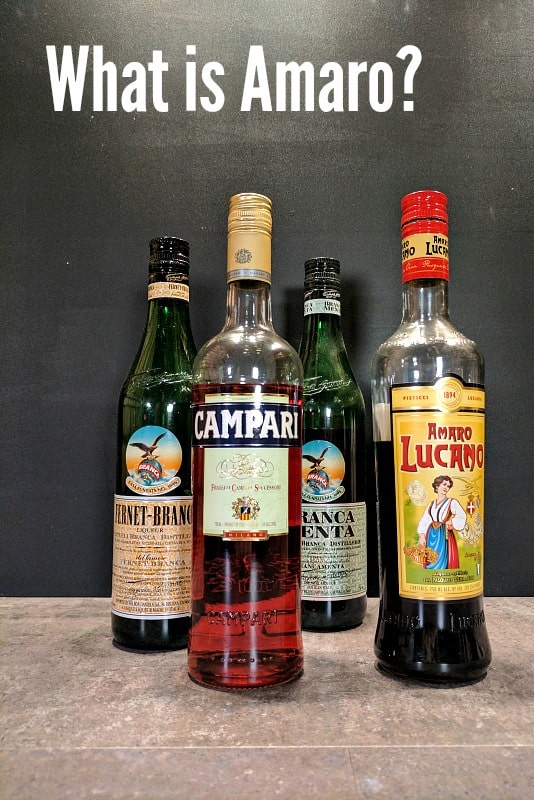Last fall, I slipped into an oil-lamp-lit booth at Midnight Cowboy in Austin, Texas for a one-of-a-kind cocktail in the secret speakeasy. My friend was late, and I told her how to find the door: it’s under a red light next to the (ostensibly) homeless man. Buzz “Harry Craddock” to get in.
Harry Craddock is the author of the classic cocktail compendium The Savoy Cocktail Book, in which he records the earliest definition of the word “cocktail”, from 1806:
“Cocktail is a stimulating liquor, composed of spirits of any kind, sugar, water, and bitters — it is vulgarly called battered sling and is supposed to be an excellent electioneering potion.”
What Is an Amaro?
One of these spirits of any kind is amaro, an herbal liqueur whose name in Italian means “bitter.” While different versions exist throughout the world, amaro is specifically Italian. It is made from infusing a base alcohol (grape brandy, neutral spirits, or wine) with a proprietary blend of herbs, roots, flowers, and spices. The concoction is aged in casks or bottles for various amounts of time, and the finished product can be anywhere from 16-40% alcohol by volume.
By the way: “Amaro” is singular and “Amari” is plural. While technically incorrect, I’ve also seen lots of people use “amaros” for plural as well.
A Brief History of Amaro
Its origins reach back to ancient Rome, where food and sex-glutted nobles would imbibe herb-infused wine for its restorative properties. In the middle ages, monks swapped wine for alcohol; by the 1800s, amaro was being sold in pharmacies and hawked by peddlers as a health tonic across Italy.
Hundreds of variations now exist, produced by monasteries or by families and passed down from generation to generation. (Source.)
Amaro vs Bitters
Amaro differs from the bitters peppered into cocktails based on whether it is meant to be drunk as a beverage or used as a flavoring. Amari are classified as “potable bitters” unlike, for example, non-potable Angostura bitters (although you can drink them on their own: the reckless take shots, the refined drink Angostura Sours).
It all comes down to the intent of the maker, not the taste:
“Some [amari] need your conscious attention to appreciate while others require fortitude to merely survive them,”
writes Mark Bitterman in Bitterman’s Field Guide to Bitters & Amari. Try a shot of Fernet and you’ll see what he means.
What Does Amaro Taste Like?
Despite the name, an amaro may have varying degrees of bitterness and may actually taste sweet (find a short list of amari from easy to intense here).
The recipes are as varied as the Italian landscape and as secret as nonna’s tomato sauce. The combinations of herbs, roots, flowers, and spices — determined by the plants found in different regions — are intended to stimulate the stomach and aid in digestion after a meal.
“Taking in small amounts of plant toxins is medicinal, killing off all sorts of harmful microorganisms hanging out in our bodies,” writes Bitterman. “In the right doses, these dangerous substances are actually helpful.”
Aside from the practical benefits, amaro is meant to be slowly sipped neat, or with a citrus wedge, ice, or tonic water — offering an excellent excuse to linger over lunch and dally after dinner.
My favorite amaro is Averna, who pinch-hits for sweet vermouth to create the Black Manhattan. Averna was originally developed by the Benedictine monks of Abbazia Di Santo Spirito, who gave the blueprint to Salvatore Averna, a textile merchant, in 1868. By 1895, Salvatore’s son was selling it to other countries; in 1912, the King of Italy Vittorio Emanuele III gave Averna the right to print the royal coat of arms on its label along with the words “Royal Household Patent.” Since then, it has spread throughout the world. The recipe hasn’t changed since 1868 and the royal coat of arms is still on the label. (Source.)
Common Amari in Cocktail Bars
Here are some of the other major players that you’re likely to find in your local cocktail bar:
Aperol, 11% abv
- Region: Padua, Italy
- History: Aperol was created by the Barbieri brothers and launched in 1919 at the Padua International Fair. On December 1, 2003, the Campari Group purchased Barbero 1891 S.p.A. and acquired Aperol.
- Taste profile: The nose is lightly alcoholic, zesty orange with appealing complex herbal scents harmonized with a touch of vanilla. The body is intense orange topped with herbal and woody notes, pleasantly bittersweet and salty. The texture is velvety and rounded, with long-lasting orange and wood memories. The backtaste is herbal, long, and pleasant, with typical bitterness. (Source.)
- Cocktail: Aperol Spritz, Paper Plane
Averna, 29% abv
- Region: Caltanissetta, Sicily
- History: In the early nineteenth century, the Benedictine monks of Abbazia Di Santo Spirito created the secret recipe. In 1868, Frà Girolamo gifted the recipe to textile merchant Salvatore Averna, who began producing it in his family farmhouse. By the early 1900s, Averna had spread across Italy and abroad. After royal approval and further success as production passed down through the family, Averna became a corporation (Fratelli Averna S.p.A.) in 1958 and was bought by the Gruppo Company in 2014.
- Taste profile: “Averna has a mouth-coating and bittersweet taste, carrying hints of orange and liquorice, balanced with notes of myrtle, juniper berries, rosemary and sage.” (Source.)
- Cocktail: Black Manhattan
Campari, 24% abv
- Region: Novara, Italy
- History: In 1860, Gaspare Campari invented a new beverage: “an alcoholic spirit obtained from the infusion of bitter herbs, aromatic plants and fruit in alcohol and water.” In 1904, the first production plant opened in Sesto San Giovanni. Since then, Campari has been involved in art, advertising, and film, celebrating its 150th Anniversary in 2010. Today it is distributed in more than 190 countries. (Source.) The website claims the recipe has remained unchanged since its creation, but in 2006 carmine, responsible for the distinctive redness and produced from cochineal beetles, was replaced with artificial coloring.
- Taste profile: Campari has a distinctive bitter taste “somewhere between orange Fanta syrup and an AA battery.” “It’s like a story in your mouth. First, you get the sweet citrus, almost like a candied orange. Then the middle part of the story is more herbal, earthy. And then right at the end, a big explosion of just … bitterness. Bright and bitter.” (Source.)
- Cocktail: Negroni
Cynar, 16.5% abv
- Region: Venice, Italy
- History: A relatively new amaro, Cynar was created by Angelo Dalle Molle in 1952 from artichoke leaves and 13 herbs and plants. He christened it with the slogan, “Cynar, against the stress of modern life.” While Cynar may have a modest history, its creator was anything but: an Italian playboy involved in the invention of the Italian electric car, Molle had six children with six different women, died at 90, and left his entire fortune to his secretary.
- Taste profile: “The nose is reminiscent of a herb garden in full bloom. The flavors are slightly bitter and quite herbal with a touch of sweetness.” (Source.)
- Cocktail: Cynar Julep
Fernet-Branca, 39% abv
- Region: Milan, Italy
- History: Bernandino Branca created Fernet-Branca in 1845, shortly thereafter founding the Fratelli Branca distillery. The recipe contains 27 herbs, roots, and spices and is a secret known today only by the president, Niccolò Branca, who personally measures out spices during production.
- Taste profile: One of those amari requiring fortitude to survive, Fernet-Branca tastes strongly of eucalyptus and menthol. Some of the herbs are chamomile, cinnamon, china, galanga, iris, myrrh, rhubarb, linden flowers, saffron, zedoary, and aloe ferox. (Source.)
- Cocktail: Hanky Panky
Lucano, 28% abv
- Region: Pisticci, Italy
- History: In 1894, in the back of his biscuit factory, Cavalier Pasquale Vena created the secret recipe from a blend of more than 30 herbs. The liqueur spread throughout Italy and the Vena family became the official supplier of the Royal House of Savoy. It grew in popularity and in the 1980s coined the catchphrase, “What else do you want from life? A Lucano!”
- Taste profile: A balanced, consistent flavor with floral notes and a whisper of citrus. Some of the herbs are artemisia absinthium, artemisia pontica, clary sage, musk yarrow, holy thistle, bitter orange, gentian, angelica, sambucus elderberry, ruta, aloe, and cinnamon essential oil. (Source.)
Montenegro, 23% abv
- Region: Bologna, Italy
- History: Montenegro was created in 1885 by Stanislao Cobianchi, who abandoned the parental plan of an ecclesial career and “left home in the spirit of adventure.” He traveled, tasted, took in information, and returned home to open a distillery and develop an amaro from 40 herbs and spices — which he named after Princess Elena of Montenegro. Italian Poet Gabriele D’Annunzio called it the “liqueur of virtues.”
- Taste profile: A wide range of bittersweet flavors including orange peel, coriander, and tea. (Source.)
Nonino, 35% abv
- Region: Friuli, Italy
- History: In 1933, distiller Antonio Nonino infused Grappa with herbs to create Amaro Carnia. In 1984, Giannola and Benito Nonino created ÙE, Grape Distillate. In 1987, their daughters started aging ÙE in different types of wood. This aged ÙE was combined with the experience of Antonio Nonino to create Amaro Nonino in 1992.
- Taste profile: “Scent of orange zest, bitter orange marmalade, thyme and menthol, with exotic notes like mango. Nice mix of sweet and bitter on the palate, perceptible pepper and liquorice; cocoa aftertaste.” – Falstaff Magazine, November 2016 (Source.)
- Cocktail: Paper Plane, Reanimator





Just “found” this stuff and had to buy a bottle.
Hits interesting notes on the palette and I look forward to ‘painting’ with it in the future.